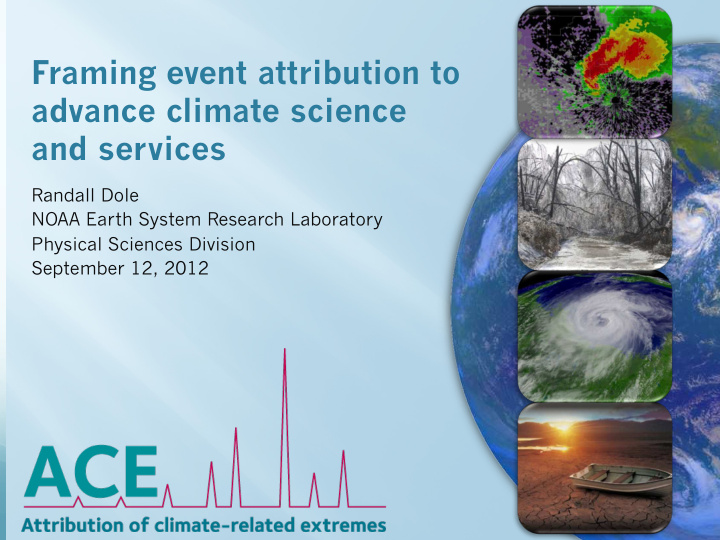



Framing event attribution to advance climate science and services Randall Dole NOAA Earth System Research Laboratory Physical Sciences Division September 12, 2012
Information needs across time scales Projections Century Decadal Predictions Decades Years Climate Seasons Outlooks Events Months Climate Variations and Change Threats 2 Week Assessments 1 Week Forecasts Days Watches Warnings & Alert Hours Coordination Minutes Actions and Decisions Warning & Preparedness Planning Adaptation Mitigation Response Addressing needs to inform policy, planning and decision-making actions across time scales requires understanding how the occurrences of weather and climate- 2 related events are conditioned by climate variations and change.
Climate Change Attribution and Event Attribution The IPCC Fourth Assessment explicitly addresses climate change attribution: Attribution of causes of climate change is the process of establishing the most likely causes for a detected change at some defined level of confidence. In parallel with the IPCC definition, for event attribution we might consider: Attribution of causes of an observed weather or climate-related event is the process of establishing the most likely causes for the event at some defined level of confidence. In distinction from climate change attribution, for event attribution: A detected change is not required, Climate variations such as ENSO can play important causal roles For recent examples, see Perlwitz et al. (2009), Pall et al. (2011), Dole et al. 3 (2010), Rupp et al. (2012)
Approaches to Event Attribution: A Medical Analogy I’ll get back to you after we’ve run So, Doc, What’s the cause? an ensemble of tests. 4
Two Approaches An epidemiological approach - provides a quantitative statistical estimate of how a given factor, in particular, human-caused climate change, alters relative risk, and hence the fraction of attributable risk, for an event as defined by some specific criteria. A diagnostic approach - applies observations, case history, diagnostic analyses and tests (model experiments) as needed to identify the most likely causes or diagnosis for a particular case. The diagnosis often carries important implications for prognosis. Both approaches are valuable, and both have limitations. Knowledge of each enriches the other. 5 September 12, 2012
Framing questions Most event attribution has been framed around one of two questions: What are the attributable human influences for an observed weather or climate event at some level of confidence? What are the most likely causes for an observed weather or climate event at some level of confidence? Addressing the first question meets needs in the IPCC and for informing long-term policy discussions, as well as other applications where attribution of human influence is the focus. Addressing the second question considers the relative roles of human forcing and other physical factors as causes of the event, including potentially predictable natural variations. The latter can be critical for informing many decisions, particularly on time scales out to seasons. 6
The Opportunities Before Us 7
Extra slides 8 September 12, 2012
Applications Scientific Basic understanding – What makes an extreme event extreme? Roles of human and natural factors; critical physical and dynamical processes. Predictability assessments – To what extent might such events be predictable? What is the maximal lead time at which useful predictive information might be provided? Observational and modeling implications – What are gaps in observational and modeling capabilities that limit our confidence in attribution (and by extension, predictions and projections of future changes)? Services Addressing public and media questions – The ability to attribute causes of observed events can be crucial to building confidence in future projections Informing decisions across time scales – Whether an event is part of a secular trend or more likely a transient variation carries important implications for planning and adaptation for future events. 9
10
Diagnostic Event Attribution Key question: What are the roles of various natural as well as human factors in observed events ? Definition: Event attribution is the process of establishing the most likely causes for an observed event at some level of confidence. Methodological approach: Strong mechanistic emphasis, predominantly applies physical-diagnostic methods Goals/applications: Improve predictive understanding of events, especially extremes. Contribute to the development of climate services by determining what information might be provided to help society to better anticipate and prepare for such events in the future. 11
Major Questions (both framings) How sensitive are our interpretations to uncertainties in trend estimation, including distinguishing human-forced trends from internal multi-decadal variations? How well do we know the range of natural variability? How well do we understand the causes of regional and seasonal variations in climate trends? Is the variability changing? If so, how? Beyond greenhouse gases, how do other human influences like aerosols and land use and land cover changes influence weather and regional climate, especially extremes? 12
Recommend
More recommend